This article is part of a series analyzing the veteran experience in the United States, especially how returning veterans transition from the military to civilian life.
PRINCETON, NJ -- One in four U.S. veterans (24%) say they know a service member or veteran who was a victim of sexual harassment, sexual assault, or rape that occurred in the military. Female veterans (60%) are three times more likely than male veterans (20%) to say they know someone who has been victimized under these circumstances.
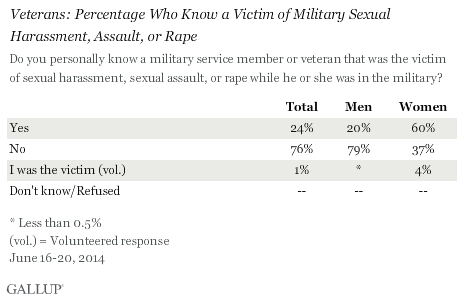
The Gallup veteran data are based on telephone interviews with 1,268 U.S. adults, aged 18 and older, who identified themselves as veterans in a Gallup Daily tracking survey, and who agreed to be recontacted for future surveys. The survey of veterans was conducted June 16-20 and includes 906 men and an oversample of 362 women.
To provide a comparative context for these veterans' reports, Gallup on July 2-3 interviewed 857 Americans in the general population who are not veterans. These nonveterans were asked whether someone they know had been the victim of sexual harassment, sexual assault, or rape by a coworker. Eighteen percent of this nonveteran sample said "yes," somewhat lower than the 24% of veterans who know a victim of sexual assault, rape, or sexual harassment in the military.
This difference largely reflects the high percentage of female veterans who know a victim from military service. Male veterans (20%) are about equally likely to know a victim in the military as male (17%) and female (19%) nonveterans are to know a victim in the workplace. Although the military is unlike most work environments in the civilian world, comparing the two highlights female veterans' extraordinarily high level of personal knowledge of a victim.
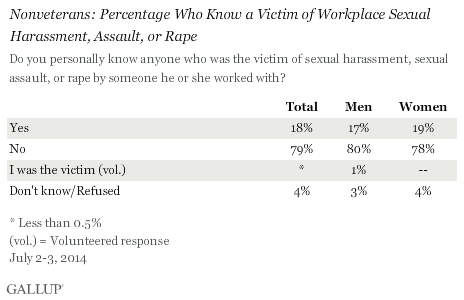
Sexual assault, rape, and repeated sexual harassment experienced during military service are categorized together as Military Sexual Trauma (MST) by the Veterans Administration. It is difficult to pinpoint how many troops and veterans are victims of MST because some experts believe only a fraction of the cases are officially reported. In the year ending Sept. 30, 2013, the Pentagon saw a 50% rise in the number of reported sexual assaults over the previous year, but it was unclear whether this constituted an increase in actual assaults or if, as a result of recent reforms, victims were beginning to feel more comfortable in coming forward. All told, the number of reported MST incidents in fiscal year 2013 totaled 5,061 sexual assaults and 1,366 incidents of sexual harassment among 1.4 million active duty U.S. troops.
Women More Likely Than Men to Say Military Not Doing Enough to Combat MST
The rise in MST reports has brought increased pressure on military leaders to step up efforts to address the problem. When asked about the military's efforts to address rape, 48% of veterans say the military has done too little. This includes 69% of female veterans and 46% of male veterans. Nonveterans are even more likely to be convinced that the military has not addressed the problem sufficiently, with 64% saying the military has done too little about rape. There is little difference between male and female nonveterans' views on this issue.
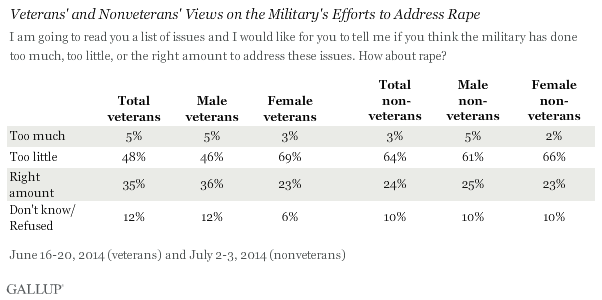
The same pattern holds regarding views of the military's efforts relating to sexual harassment. Four in 10 veterans surveyed (42%) say the military has done too little to address sexual harassment, lower than the 51% of nonveterans who hold this view. Male nonveterans are more likely than male veterans to perceive that the military has done too little on this issue, while the reverse holds true among women.
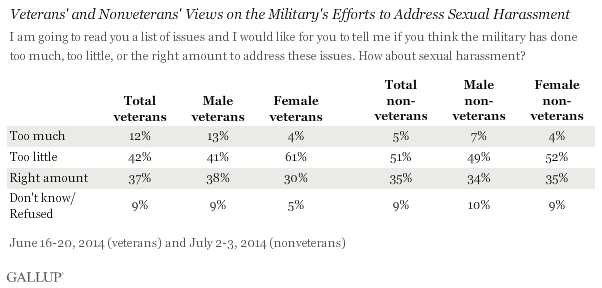
When asked about the military's handling of "other forms of sexual assault," 46% of veterans surveyed say the military has done too little to combat the problem, compared with 61% of nonveterans. Here, female veterans and female nonveterans are similar in their views, while male nonveterans are significantly more likely than male veterans to say the military has done too little.
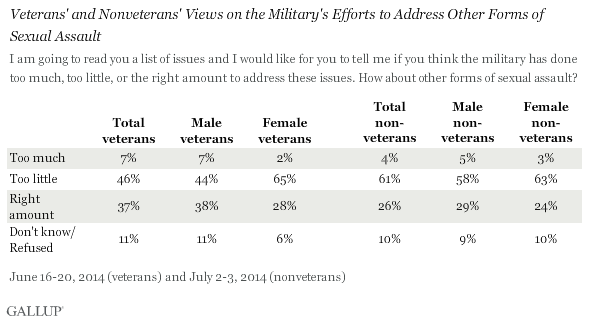
Bottom Line
More than half of women who have served in the military report knowing someone who has been the victim of rape, sexual harassment, or sexual assault while in the military, much higher than the comparable percentage of female nonveterans who know someone who has been such a victim of a coworker. These results suggest that sexual victimization is a real and substantial problem in the military, and that significant percentages of veterans and nonveterans alike -- particularly including female veterans -- perceive that the military is doing too little to address these issues.
The issue of MST garnered national attention this past winter, with a proposed Senate bill to make it easier for service members to report sexual assaults by shifting prosecution outside the chain of command. The measure was eventually defeated while a less controversial bill advanced to the House, but the media coverage helped bring the issue to the forefront for the public. This may partly explain why majorities of nonveterans say the military is not doing enough to address sexual assault, rape, and sexual harassment in the armed services. In fact, nonveterans are more likely than veterans to say the military has done too little to address MST issues, suggesting that the public widely perceives such conduct as a problem.
Survey Methods
Results of the veterans survey are based on telephone interviews conducted June 16-20, 2014, with a random sample of 1,268 retired and discharged veterans, aged 18 and older, living in all 50 U.S. states and the District of Columbia. Members of the Individual Ready Reserve, National Guard and Reserve were not included in this study.
For results based on the total sample of veterans, the margin of sampling error is ±3 percentage points at the 95% confidence level.
Interviews were conducted using Gallup Daily tracking survey Recontact Sample. Gallup Daily tracking survey Recontact Sample includes respondents that previously participated in the Gallup Daily tracking survey, and agreed to future contact. The sample universe for this study included Gallup Daily tracking Recontact respondents that previously reported they were veterans.
Data are weighted by age and gender using targets derived from the Gallup Daily tracking surveys for the veteran population.
The Gallup nonveteran data are based on telephone interviews with 1,016 national adults conducted July 2-3, 2014, on the Gallup Daily tracking survey.
For results based on the total sample of nonveterans, the margin of sampling error is ±4 percentage points at the 95% confidence level.
Gallup Daily tracking survey interviews are conducted with respondents on landline telephones and cellular phones, with interviews conducted in Spanish for respondents who are primarily Spanish-speaking. Each sample of national adults includes a minimum quota of 50% cellphone respondents and 50% landline respondents, with additional minimum quotas by time zone within region. Landline and cellular telephone numbers are selected using random-digit-dial methods. Landline respondents are chosen at random within each household on the basis of which member had the most recent birthday.
Samples are weighted to correct for unequal selection probability, nonresponse, and double coverage of landline and cell users in the two sampling frames. They are also weighted to match the national demographics of gender, age, race, Hispanic ethnicity, education, region, population density, and phone status (cellphone only/landline only/both, and cellphone mostly). Demographic weighting targets are based on the most recent Current Population Survey figures for the aged 18 and older U.S. population. Phone status targets are based on the most recent National Health Interview Survey. Population density targets are based on the most recent U.S. census. All reported margins of sampling error include the computed design effects for weighting.
In addition to sampling error, question wording and practical difficulties in conducting surveys can introduce error or bias into the findings of public opinion polls.
For more details on Gallup's polling methodology, visit www.gallup.com.
